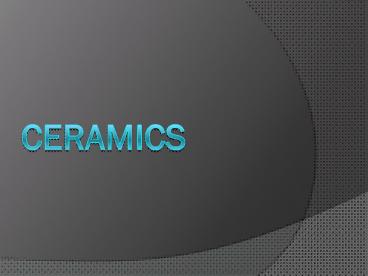CERAMICS - PowerPoint PPT Presentation
Title: CERAMICS
1
CERAMICS
2
Properties of Ceramic
- They are distiguished by its bonding which is
ionic or covalent bonding - High elastic modulus and hardness
- High melting point
- Low thermal expansion
- Good chemical resistance
- Brittle
- Thermal insulators
- Electrical insulators
- Nonmagnetic
3
Ceramic Structures Crystal Structure
- Factors that affect crystal structure of ceramics
- - the magnitude of the electrical charge on each
of the component ions and the relative sizes of
the cations and anions - - the sizes or ionic radii of the cations and
anions rC/rA
4
Ceramic Structures
- Crystal structures
- Atomic bonding ionic bonding
- Positive charges (metal) cation
- Negative charges (non metal) anion
anion
kation
5
AX-Type Crystal Structures
- A cation X anion
- Rock Salt Structure
- e.g NaCl, MgO, MnS, LiF
- The coordination
- number for both
- cationsanions 6
- Structure FCC
6
- 2. Cesium Chloride Structure
- The coordination number 8
- e.g CsCl
- Zinc Blende Structure
- The coordination
- number 4
- atomic bonding
- covalent bonding
- e.g ZnS, ZnTe, SiC
7
AmXp-Type Crrystal Structure
- When charges of cations and anions are not the
same where m and/or p ? 1 - AX2 e.g CaF2, UO2, PuO2
8
AmBnXp-Type Crystal Structures
- It is possible for ceramic compounds to have more
than one type of cation - A B cation X anion
- Structure perovskite
- e.g BaTiO3
- (Barium titanat)
- cation Ba2, Ti4
- anion O2-
9
Classification of Ceramics
- Glasses 1. Glasses
- 2. Glass-ceramics
- Clay Products 1. Structural clay products
- 2. Whitewares
- Refractories 1. Fireclay
- 2. Silica
- 3. Basic
- 4. Special
- Abrasives
- Cements
- Advanced ceramics
10
Glasses (1)
- Glasses
- They are noncrystalline silicates containing
other oxides
Glass Type Composition SiO2 Na2O CaO Al2O3 B2O3 Other Characteristics and Application
Fused Silica gt99.5 High melting temperature, very low coefficient of expansion (thermally schok resistant)
96 Silica (VycorTM) 96 4 Thermally shock and chemically resistant laboratory ware
Borosilicate (PyrexTM) 81 3.5 2.5 13 Thermally shock and cehimcally resistant ovenware
11
Glasses (2)
- 2. Glass-ceramics
- Formed glass ceramics We use a process that
called crystallization which is the most
inorganic glasses can be made to transform from a
noncrystalline state to one that is crystalline
by the proper high temperature heat treatment - Properties relatively high mechanical strength,
low coefficients of thermal expansion, relatively
high temperature capabilities, good dielectric
properties, good biological compability - Applications ovenware, tableware, oven windows,
and rangetops, and etc
12
Clay Products
- 1. Structural clay products
- Applications building bricks, tiles, and sewer
pipes - 2. Whitewares
- Whitewares become white after the high
temperature firing - Applications porcelain, pottery, tableware,
china and plumbing fixtures (sanitary ware)
13
Refractories (1)
- Fireclay refractories
- The primary ingredients high purity fireclays,
alumina, and silica mixtures usually containing
between 25 and 45 wt alumina. - Applications in furnace construction, to cofine
hot atmospheres and to thermally insulates
structural members from excessive temperatures. - 2. Silica refractories
- Contains over 95 of SiO 2 and not more than 3
CaO both by weight - Well known for their high temperature load
bearing capacitiy - Applications arched roof of steel and glass
making furnaces
14
Refractories (2)
- 3. Basic refractories
- Have a high propotions of basic content like CaO
and MgO. Also contain chromium and iron compounds - Applications use in some steel making open
hearth furnaces - 4. Special refractories
- Some of these are relatively high purity oxide
materials - Applications For example SiC are used for
electrical resistance heating elements
15
Abrasives
- The most common examples of abrasives are
diamond, silicon carbide, tungsten carbide,
corundum, and silica sand - The prime requisite of this material is hardness
- Applications bonded in grinding wheels, as
coated abrasives, as loose grains, etc
16
Cements
- Cement used in construction is characterized as
hydraulic and non-hydraulic - The characteristic feature in this material is
when mixed with water, form a paste - Cementitious bond develops at room temperature
- Applications mortar and concrete
17
Advanced Ceramics (1)
- MEMS (Microelectromechanical Systems)
- Miniature smart system consisting of a
multitude of mechanical devices that are
integrared with a large numbers of electrical
elements on a substrate of silicon - Applications accelerometer, microsystem for
DNA, chemical detectors, etc
18
Advanved Ceramics (2)
- 2. Optical Fibers
- Is made of extremely high purity silica
- 3. Ceramic Ball Bearings
- Consists of balls and races that are in contact
with and rub against one another when in use
19
Fabrication and Processing Of Ceramics (1)
- Fabrication and Processing Of Glasses and
Glass-ceramics - Glasses are formed at elevated temperature,
hence, we have to consider the temperature
viscosity - Glass forming techniques pressing, blowing,
drawing and fiber forming - After fabrication, glasses may be annealed and/or
tempered to improve mechanical characteristics
20
Fabrication and Processing Of Ceramics (2)
- 2. Fabrication and Processing of Clay Products
- Commonly, there are two forming techniques,
hydroplastic forming and slip casting - After forming, the body must be dried and then
fired at elevated temperature - 3. Powder Pressing
- Used to fabricate both clay and non clay
compositions - Three basic powder pressing uniaxial,
isostatic, and hydro pressing - 4. Tape Casting
- Pouring the slip onto a flat surface
- A doctor blade spreads the slip into a thin tape
of uniform thickness - Tape thickness normally range between 0.1 and 2
mm - Usually used in the production of ceramic
substrates































